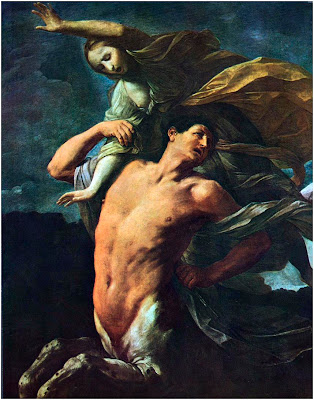Major exhibitions that recently took place in Vienna and Frankfurt highlighted the unusual source of inspiration for 'Ecce homo' by Rubens - the marble centaur’s torso. This curios connection should be explored a bit further:
Johann Carl Loth, The Suicide of Cato the Younger, 1647-48. Copenhagen
Guido Reni. (1575 - 1642) The Abduction of Deianeira
Detail. Oil on canvas. 257 by 195. Before 1630. This painting was recorded at Prague Castle in 1685 and still can be seen there.
As usual in Art History it is hard to say with an absolute degree of certainty whether there was indeed a borrowing by Carl Loth from Guido Reni or is it just some kind of coincidental similarity. This question arises many times in regard to the treatment of multiple subjects by various artists. How close one pose really should be to some other one so that it can be considered a possible source? The factor of chronological or geographical proximity apparently has more weight in these cases: "Artist X visited Venice for a short period of time where he was likely inspired by an altarpiece made by an artist Y, so the figure in the left corner is modelled on..." But can it always be a satisfactory explanation?
It is quite odd that to my knowledge no database of the supposed borrowings was ever compiled by anyone likely due to the fact that there are just too many possible sources. So it is not easy to check for yourself whether some kind of relation was previously observed by someone and might have merit or not. It is not particularly compelling for historians to admit a random concurrence rather than to look for suitable figural prototypes. A suggestion that some pictorial solutions were invented by Old Masters completely independently could be a funny exercise in its own right.



Комментариев нет:
Отправить комментарий